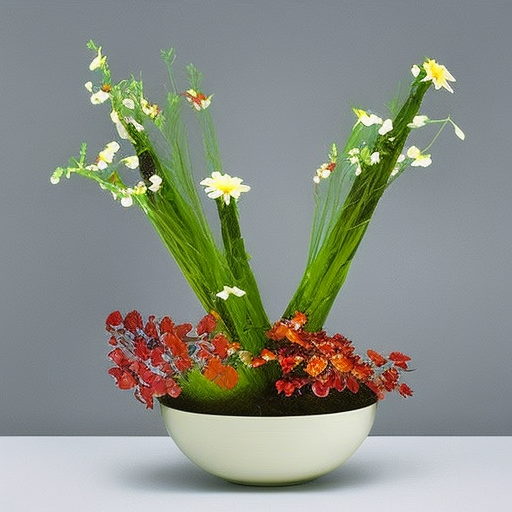Ikebana: The Art of Japanese Flower Arrangement
Ikebana is the traditional Japanese art of flower arrangement that dates back to the 7th century. It is a disciplined practice that involves the creation of harmonious and balanced floral compositions. Ikebana is not just about arranging flowers; it is a form of artistic expression that reflects the beauty of nature and the principles of Japanese aesthetics.
History and Origins
The origins of Ikebana can be traced back to Buddhist rituals in India, where flowers were offered to the gods. When Buddhism spread to Japan in the 6th century, the practice of offering flowers became an integral part of religious ceremonies. Over time, Ikebana evolved from a religious ritual to a form of artistic expression.
Principles and Techniques
Ikebana follows a set of principles and techniques that guide the arrangement of flowers. The most fundamental principle is the concept of asymmetry, which reflects the imperfections and irregularities found in nature. Ikebana also emphasizes the use of empty space, known as “ma,” which allows the viewer to appreciate the beauty of each individual flower.
There are various schools of Ikebana, each with its own unique style and techniques. The most well-known school is the Ikenobo School, which was established in the 15th century. Other prominent schools include the Sogetsu School and the Ohara School. Each school has its own set of rules and techniques, but they all share the common goal of creating harmonious and balanced arrangements.
Materials and Tools
Ikebana arrangements typically include a combination of flowers, branches, leaves, and other natural materials. The choice of materials depends on the season, the occasion, and the desired aesthetic. Traditional Ikebana often incorporates elements such as bamboo, pine, and cherry blossoms, which hold symbolic meanings in Japanese culture.
To create Ikebana arrangements, practitioners use a variety of tools, including a kenzan (a metal pin holder), scissors, and a vase or container. The kenzan is essential for securing the stems and branches in place, allowing the artist to create intricate and delicate compositions.
Meaning and Symbolism
Ikebana is not just about arranging flowers; it is also a means of communication and self-expression. Each element in an Ikebana arrangement holds symbolic meaning. The choice of flowers, their placement, and the overall composition convey messages and evoke emotions.
Ikebana arrangements often reflect the changing seasons and the beauty of nature. They can also express concepts such as harmony, balance, and tranquility. Ikebana is deeply rooted in Japanese culture and is often associated with Zen Buddhism, which emphasizes mindfulness and the appreciation of the present moment.
Contemporary Ikebana
While Ikebana has deep traditional roots, it has also evolved to embrace contemporary styles and techniques. Contemporary Ikebana artists often experiment with unconventional materials, colors, and forms, pushing the boundaries of the art form.
Contemporary Ikebana also emphasizes the importance of individual expression and creativity. Artists are encouraged to interpret the principles of Ikebana in their own unique way, resulting in a diverse range of styles and approaches.
Appreciating Ikebana
To fully appreciate Ikebana, it is important to understand its cultural and aesthetic significance. Observing an Ikebana arrangement requires a keen eye for detail and an appreciation for the beauty of simplicity. The viewer is encouraged to take their time and contemplate the arrangement, allowing the subtle nuances and symbolism to unfold.
Ikebana is not just a visual art form; it also engages the senses of touch and smell. The textures and scents of the flowers and foliage add another layer of depth to the experience.
In conclusion, Ikebana is a highly regarded art form that embodies the principles of Japanese aesthetics and the beauty of nature. It is a disciplined practice that requires skill, creativity, and an understanding of the symbolic meaning behind each element. Whether traditional or contemporary, Ikebana arrangements have the power to evoke emotions, inspire contemplation, and bring a sense of harmony and tranquility to any space.












